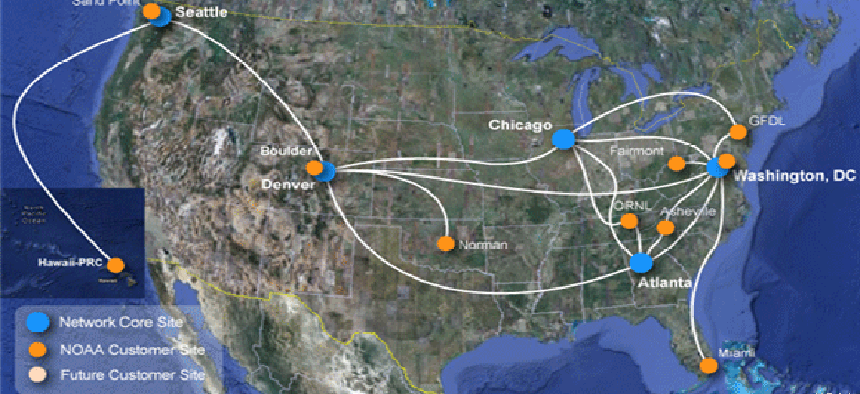NOAA's 10G network keeps the terabytes coming


Connecting state and local government leaders
The high-speed N-Wave network can scale up to a 100 gigabits/sec to accommodate the massive amount of weather and climate modeling data generated every day.
A high-speed gigabit network is giving scientists and researchers at the National Oceanic and Atmospheric Administration secure access to large volumes of complex, high-resolution climate and weather images and data.
N-Wave, a 10-gigabit Ethernet wide-area network, connects NOAA’s high-performance computing sites, data archives and researchers. N-Wave has the ability to scale to a 100-gigabit Ethernet and beyond as research demands increases and next-generation services are added to the network.
As scientists generate increasingly sophisticated, predictive models of the weather, climate change and the impact of environmental incidents, they need to transfer massive amounts of data and collaborate without network constraints. Some of the models consume so much network bandwidth that in the past NOAA scientists and their collaborators had to ship hard drives to each other to share data.
Some NOAA divisions are looking at generating 80 to 100 terabytes per day of model output, so reaching 100G is not that far off for NOAA, said Jerry Janssen, director and manager of N-Wave, who works at NOAA’s Earth System Research Laboratory in Boulder, Colo.
To get a sense of the type of data flow occurring across NOAA’s operations, consider these two examples:
- NOAA’s Research and Development High Performance Computing System, operated jointly by the agency’s Oceanic and Atmospheric Office and National Weather Service, moves 40 terabytes of data a day and peaks at 60 terabytes.
- NOAA’s Satellite Program is moving 9 terabytes of data per day. NASA and NOAA are jointly launching next-generation satellites, which should increase the output to 25 terabytes a day. And that is just the archived data, Janssen noted.
“These types of data flows are real,” Janssen said, are the primary reason why N-Wave was built. “Our backbone has been running at 100 percent availability since January 2010,” he added, when N-Wave was launched.
N-Wave is a highly scalable, stable, and secure network with 10 gigabits/sec wavelength-division multiplexing, and fiber-optic links supplied by partners in the national research and education network communities, Janssen noted.
The N-Wave network relies on Cisco’s Carrier Routing System (CRS) to manage data traffic on its Multiprotocol Label Switching (MPLS) backbone. CRS is a meshed system with redundant routers, able to route traffic elsewhere if a communications link goes down. CRS also has a self-healing, distributed operating system and can handle the multidirectional traffic of network and data center cloud interactions.
Because of the architecture, N-Wave can build multiple private MPLS networks within its own infrastructure. “We can have independent networks for different high-volume data sets and they can have their own 10G connection,” Janssen said.
Cisco is a primary partner, having invested in the network, Janssen said. Other network vendors’ equipment is also used in N-Wave, such as routers and switches from Juniper Networks. That way NOAA can fit the technology to the best location. For instance, Juniper routers have been deployed closer to the edge of the network providing connectivity and firewall capabilities to multiple business offices.
N-Wave has five core backbone sites in Denver, Chicago, Atlanta, McLean, Va., and Seattle. “That allows close proximity to most NOAA networked sites, so we can provide 10G connectivity,” Janssen said. Partner sites are located around the country, from Washington, D.C., to Miami to Boulder, Colo. The network also includes a remote research center in Hawaii and will soon connect to one in Alaska.
Janssen said N-Wave gives NOAA the ability to link with partners such as the Energy Department, which with NOAA shares many locations, as well as the Interior Department and NASA. Although the work in this area is ongoing, Janssen said, “We are well situated to provide close connections.”
“We are not actually passing traffic between the organizations,” mainly because the agencies are still trying to figure out how to deal with issues such as the Trusted Internet Connection, Janssen said. TIC is an initiative to improve the federal government security posture and incident response capability through the reduction and consolidation of external network connections.
NOAA had a model to follow as the agency built out N-Wave because DOE had already shown how to build a high-speed, scalable network to connect scientists and researchers with its Energy Sciences Network (ESnet), Janssen said.
“We didn’t create our own wheel. We just re-created what ESnet has been doing for years” with some differences, he explained.
So are there any NOAA scientists or researchers still shipping out hard drives to share big data weather models? Well, “there are still some places doing that,” Janssen admitted. “We’re trying to move them into a new way of thinking.”




